Florian Metze
CRAG-MM: Multi-modal Multi-turn Comprehensive RAG Benchmark
Oct 30, 2025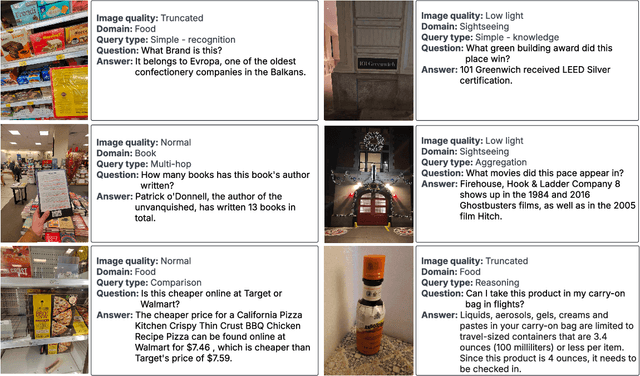


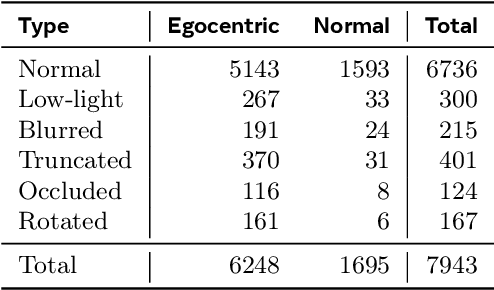
Abstract:Wearable devices such as smart glasses are transforming the way people interact with their surroundings, enabling users to seek information regarding entities in their view. Multi-Modal Retrieval-Augmented Generation (MM-RAG) plays a key role in supporting such questions, yet there is still no comprehensive benchmark for this task, especially regarding wearables scenarios. To fill this gap, we present CRAG-MM -- a Comprehensive RAG benchmark for Multi-modal Multi-turn conversations. CRAG-MM contains a diverse set of 6.5K (image, question, answer) triplets and 2K visual-based multi-turn conversations across 13 domains, including 6.2K egocentric images designed to mimic captures from wearable devices. We carefully constructed the questions to reflect real-world scenarios and challenges, including five types of image-quality issues, six question types, varying entity popularity, differing information dynamism, and different conversation turns. We design three tasks: single-source augmentation, multi-source augmentation, and multi-turn conversations -- each paired with an associated retrieval corpus and APIs for both image-KG retrieval and webpage retrieval. Our evaluation shows that straightforward RAG approaches achieve only 32% and 43% truthfulness on CRAG-MM single- and multi-turn QA, respectively, whereas state-of-the-art industry solutions have similar quality (32%/45%), underscoring ample room for improvement. The benchmark has hosted KDD Cup 2025, attracting about 1K participants and 5K submissions, with winning solutions improving baseline performance by 28%, highlighting its early impact on advancing the field.
Stream RAG: Instant and Accurate Spoken Dialogue Systems with Streaming Tool Usage
Oct 02, 2025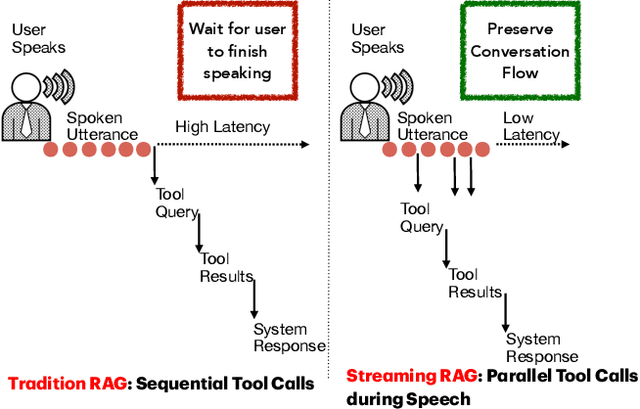
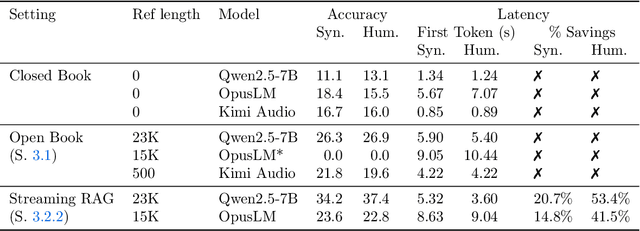
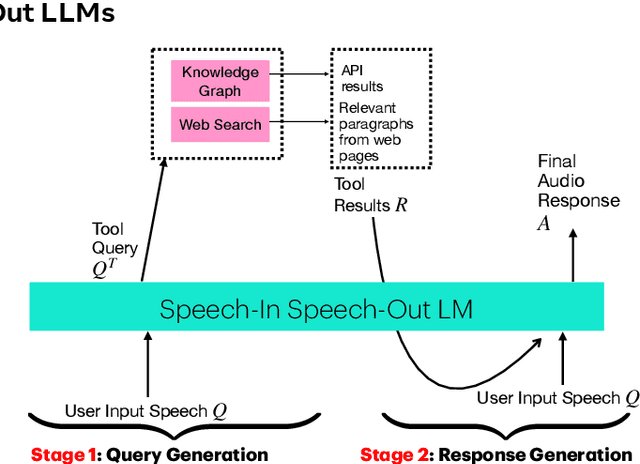
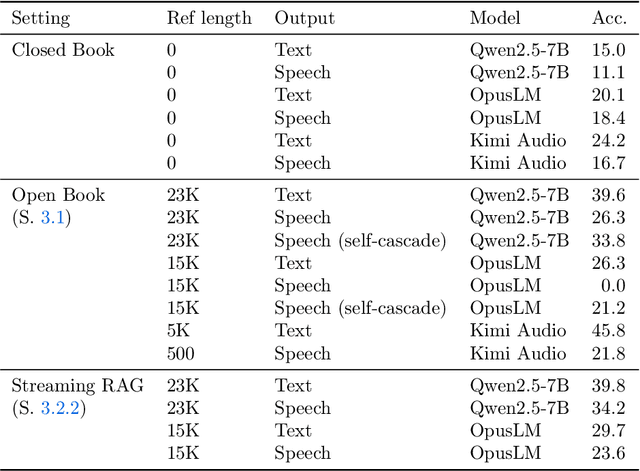
Abstract:End-to-end speech-in speech-out dialogue systems are emerging as a powerful alternative to traditional ASR-LLM-TTS pipelines, generating more natural, expressive responses with significantly lower latency. However, these systems remain prone to hallucinations due to limited factual grounding. While text-based dialogue systems address this challenge by integrating tools such as web search and knowledge graph APIs, we introduce the first approach to extend tool use directly into speech-in speech-out systems. A key challenge is that tool integration substantially increases response latency, disrupting conversational flow. To mitigate this, we propose Streaming Retrieval-Augmented Generation (Streaming RAG), a novel framework that reduces user-perceived latency by predicting tool queries in parallel with user speech, even before the user finishes speaking. Specifically, we develop a post-training pipeline that teaches the model when to issue tool calls during ongoing speech and how to generate spoken summaries that fuse audio queries with retrieved text results, thereby improving both accuracy and responsiveness. To evaluate our approach, we construct AudioCRAG, a benchmark created by converting queries from the publicly available CRAG dataset into speech form. Experimental results demonstrate that our streaming RAG approach increases QA accuracy by up to 200% relative (from 11.1% to 34.2% absolute) and further enhances user experience by reducing tool use latency by 20%. Importantly, our streaming RAG approach is modality-agnostic and can be applied equally to typed input, paving the way for more agentic, real-time AI assistants.
Multi-Channel Differential ASR for Robust Wearer Speech Recognition on Smart Glasses
Sep 17, 2025Abstract:With the growing adoption of wearable devices such as smart glasses for AI assistants, wearer speech recognition (WSR) is becoming increasingly critical to next-generation human-computer interfaces. However, in real environments, interference from side-talk speech remains a significant challenge to WSR and may cause accumulated errors for downstream tasks such as natural language processing. In this work, we introduce a novel multi-channel differential automatic speech recognition (ASR) method for robust WSR on smart glasses. The proposed system takes differential inputs from different frontends that complement each other to improve the robustness of WSR, including a beamformer, microphone selection, and a lightweight side-talk detection model. Evaluations on both simulated and real datasets demonstrate that the proposed system outperforms the traditional approach, achieving up to an 18.0% relative reduction in word error rate.
Thinking in Directivity: Speech Large Language Model for Multi-Talker Directional Speech Recognition
Jun 17, 2025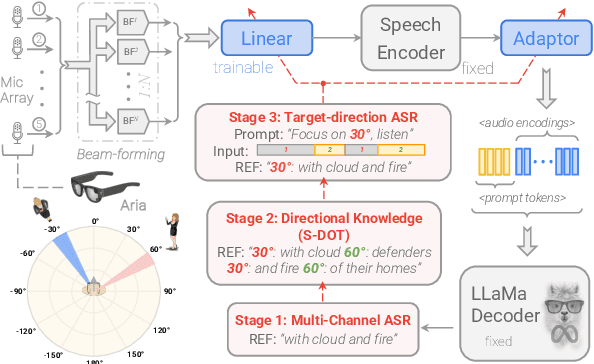
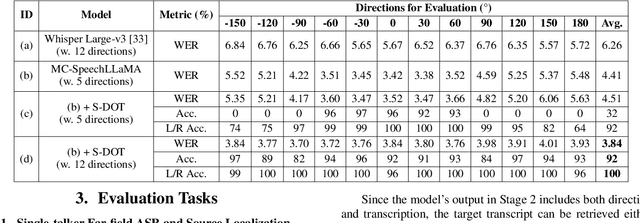
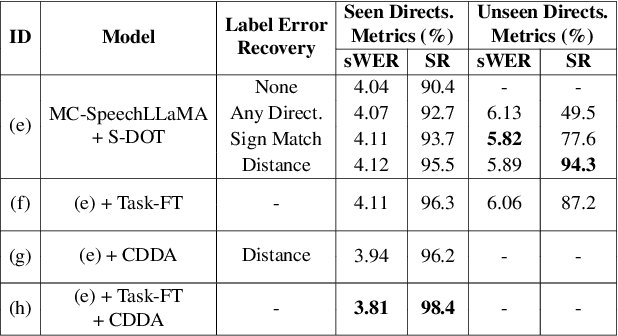
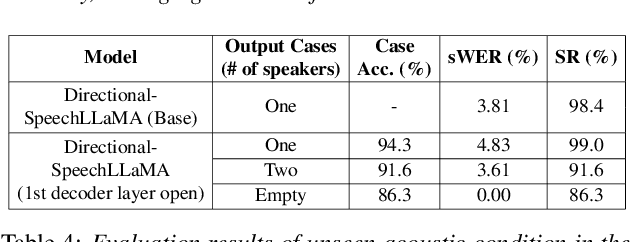
Abstract:Recent studies have demonstrated that prompting large language models (LLM) with audio encodings enables effective speech recognition capabilities. However, the ability of Speech LLMs to comprehend and process multi-channel audio with spatial cues remains a relatively uninvestigated area of research. In this work, we present directional-SpeechLlama, a novel approach that leverages the microphone array of smart glasses to achieve directional speech recognition, source localization, and bystander cross-talk suppression. To enhance the model's ability to understand directivity, we propose two key techniques: serialized directional output training (S-DOT) and contrastive direction data augmentation (CDDA). Experimental results show that our proposed directional-SpeechLlama effectively captures the relationship between textual cues and spatial audio, yielding strong performance in both speech recognition and source localization tasks.
MASV: Speaker Verification with Global and Local Context Mamba
Dec 14, 2024


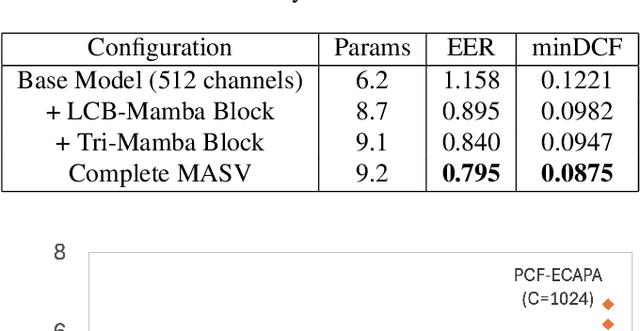
Abstract:Deep learning models like Convolutional Neural Networks and transformers have shown impressive capabilities in speech verification, gaining considerable attention in the research community. However, CNN-based approaches struggle with modeling long-sequence audio effectively, resulting in suboptimal verification performance. On the other hand, transformer-based methods are often hindered by high computational demands, limiting their practicality. This paper presents the MASV model, a novel architecture that integrates the Mamba module into the ECAPA-TDNN framework. By introducing the Local Context Bidirectional Mamba and Tri-Mamba block, the model effectively captures both global and local context within audio sequences. Experimental results demonstrate that the MASV model substantially enhances verification performance, surpassing existing models in both accuracy and efficiency.
Error-aware Quantization through Noise Tempering
Dec 11, 2022



Abstract:Quantization has become a predominant approach for model compression, enabling deployment of large models trained on GPUs onto smaller form-factor devices for inference. Quantization-aware training (QAT) optimizes model parameters with respect to the end task while simulating quantization error, leading to better performance than post-training quantization. Approximation of gradients through the non-differentiable quantization operator is typically achieved using the straight-through estimator (STE) or additive noise. However, STE-based methods suffer from instability due to biased gradients, whereas existing noise-based methods cannot reduce the resulting variance. In this work, we incorporate exponentially decaying quantization-error-aware noise together with a learnable scale of task loss gradient to approximate the effect of a quantization operator. We show this method combines gradient scale and quantization noise in a better optimized way, providing finer-grained estimation of gradients at each weight and activation layer's quantizer bin size. Our controlled noise also contains an implicit curvature term that could encourage flatter minima, which we show is indeed the case in our experiments. Experiments training ResNet architectures on the CIFAR-10, CIFAR-100 and ImageNet benchmarks show that our method obtains state-of-the-art top-1 classification accuracy for uniform (non mixed-precision) quantization, out-performing previous methods by 0.5-1.2% absolute.
Normalized Contrastive Learning for Text-Video Retrieval
Nov 30, 2022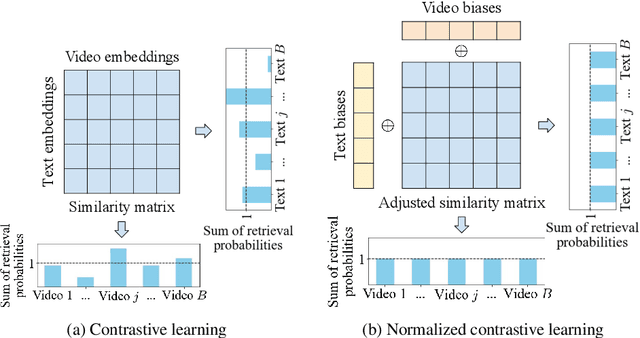
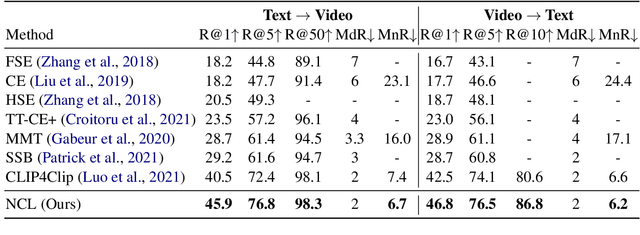

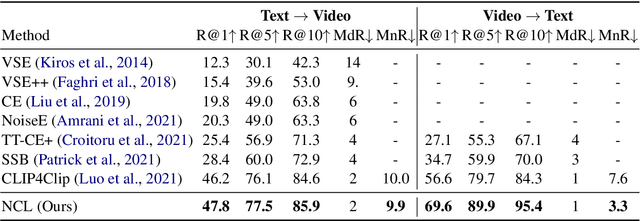
Abstract:Cross-modal contrastive learning has led the recent advances in multimodal retrieval with its simplicity and effectiveness. In this work, however, we reveal that cross-modal contrastive learning suffers from incorrect normalization of the sum retrieval probabilities of each text or video instance. Specifically, we show that many test instances are either over- or under-represented during retrieval, significantly hurting the retrieval performance. To address this problem, we propose Normalized Contrastive Learning (NCL) which utilizes the Sinkhorn-Knopp algorithm to compute the instance-wise biases that properly normalize the sum retrieval probabilities of each instance so that every text and video instance is fairly represented during cross-modal retrieval. Empirical study shows that NCL brings consistent and significant gains in text-video retrieval on different model architectures, with new state-of-the-art multimodal retrieval metrics on the ActivityNet, MSVD, and MSR-VTT datasets without any architecture engineering.
Token-level Sequence Labeling for Spoken Language Understanding using Compositional End-to-End Models
Oct 27, 2022Abstract:End-to-end spoken language understanding (SLU) systems are gaining popularity over cascaded approaches due to their simplicity and ability to avoid error propagation. However, these systems model sequence labeling as a sequence prediction task causing a divergence from its well-established token-level tagging formulation. We build compositional end-to-end SLU systems that explicitly separate the added complexity of recognizing spoken mentions in SLU from the NLU task of sequence labeling. By relying on intermediate decoders trained for ASR, our end-to-end systems transform the input modality from speech to token-level representations that can be used in the traditional sequence labeling framework. This composition of ASR and NLU formulations in our end-to-end SLU system offers direct compatibility with pre-trained ASR and NLU systems, allows performance monitoring of individual components and enables the use of globally normalized losses like CRF, making them attractive in practical scenarios. Our models outperform both cascaded and direct end-to-end models on a labeling task of named entity recognition across SLU benchmarks.
SQuAT: Sharpness- and Quantization-Aware Training for BERT
Oct 13, 2022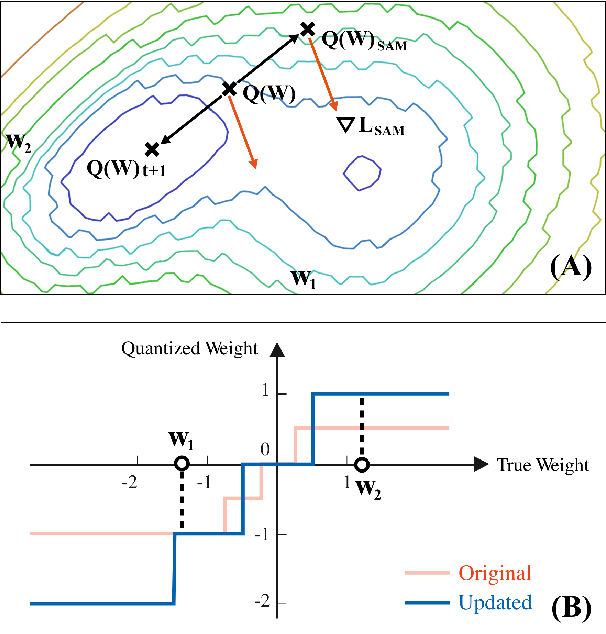

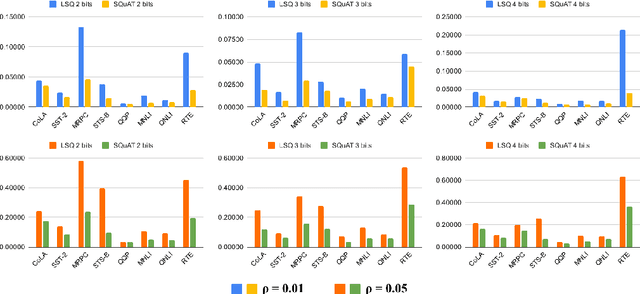
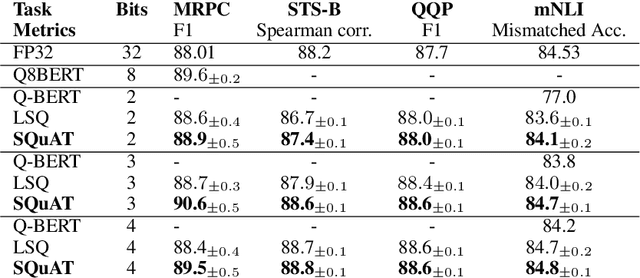
Abstract:Quantization is an effective technique to reduce memory footprint, inference latency, and power consumption of deep learning models. However, existing quantization methods suffer from accuracy degradation compared to full-precision (FP) models due to the errors introduced by coarse gradient estimation through non-differentiable quantization layers. The existence of sharp local minima in the loss landscapes of overparameterized models (e.g., Transformers) tends to aggravate such performance penalty in low-bit (2, 4 bits) settings. In this work, we propose sharpness- and quantization-aware training (SQuAT), which would encourage the model to converge to flatter minima while performing quantization-aware training. Our proposed method alternates training between sharpness objective and step-size objective, which could potentially let the model learn the most suitable parameter update magnitude to reach convergence near-flat minima. Extensive experiments show that our method can consistently outperform state-of-the-art quantized BERT models under 2, 3, and 4-bit settings on GLUE benchmarks by 1%, and can sometimes even outperform full precision (32-bit) models. Our experiments on empirical measurement of sharpness also suggest that our method would lead to flatter minima compared to other quantization methods.
CTC Alignments Improve Autoregressive Translation
Oct 11, 2022
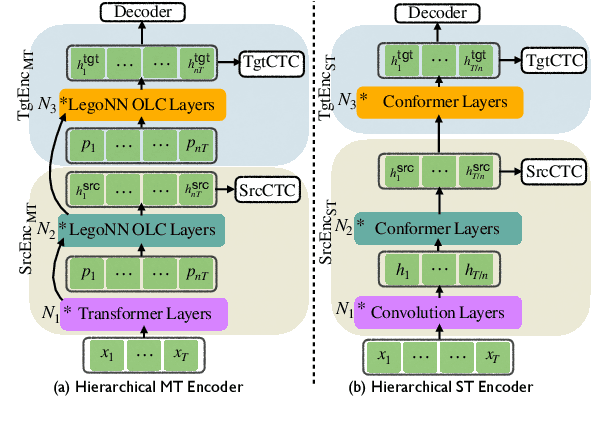
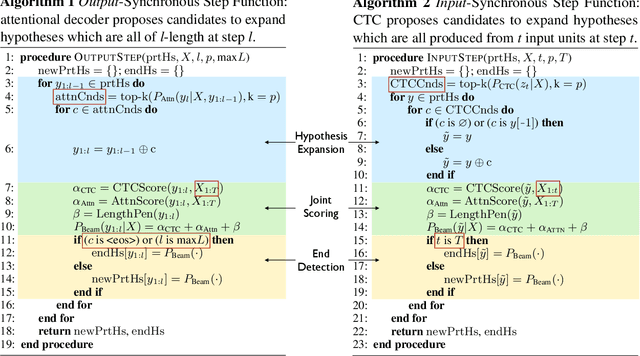

Abstract:Connectionist Temporal Classification (CTC) is a widely used approach for automatic speech recognition (ASR) that performs conditionally independent monotonic alignment. However for translation, CTC exhibits clear limitations due to the contextual and non-monotonic nature of the task and thus lags behind attentional decoder approaches in terms of translation quality. In this work, we argue that CTC does in fact make sense for translation if applied in a joint CTC/attention framework wherein CTC's core properties can counteract several key weaknesses of pure-attention models during training and decoding. To validate this conjecture, we modify the Hybrid CTC/Attention model originally proposed for ASR to support text-to-text translation (MT) and speech-to-text translation (ST). Our proposed joint CTC/attention models outperform pure-attention baselines across six benchmark translation tasks.
 Add to Chrome
Add to Chrome Add to Firefox
Add to Firefox Add to Edge
Add to Edge